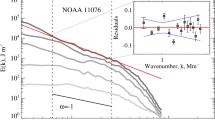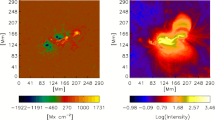Abstract
Scatter plots of various pairs of spectral-line parameters that describe the magnetic field and the line-of-sight velocity are discussed in order to relate magnetic structures and the line-of-sight velocity field with characteristic areas of an emerging flux region (EFR).
Strong magnetic fields, occurring over about 20% of the resolution elements in the EFR, are either slightly to moderately inclined or transverse. Slightly to moderately inclined strong fields occur in patches near the border of the EFR; the filling factors per resolution element are large, and field strengths are between 800 and 2000 G, and up to 2500 G in pores. There are only a few faculae in the EFR; most of these are located near rapidly growing pores of following polarity.
The strongly inclined strong magnetic fields, with field strengths exceeding 1000 G, are located in slightly darkened resolution elements near the line B ∥ = 0 separating the magnetic polarities, near large-scale and small-scale upflows. In the central region of the EFR there are some small elements with strongly inclined field of low average field strength of about 500 G, and a tendency for a small-scale upward velocity. These elements may correspond to tops of flux loops during emergence.
In 80% of the resolution elements within the EFR the magnetic flux density (averaged over the resolution element) is low, less than 120 G.
There is a persistent large-scale velocity field, with upflows near the line B ∥ = 0 separating the magnetic polarities and with downflows near rapidly growing pores of following polarity. Some examples of strong small-scale upflows are found in the central region of the EFR, and strong small-scale downflows near rapidly growing following pores. Within the pores and faculae there are no significant small-scale line-of-sight velocities.
Similar content being viewed by others
References
Brants, J. J.: 1985, Solar Phys. 95, 15 (Paper II).
Brants, J. J. and Steenbeek, J. C. M.: 1985, Solar Phys. 96, 229.
Brants, J. J. and Zwaan, C.: 1982, Solar Phys. 80, 251.
Hubenet, H.: 1954, Z. Astrophys. 34, 110.
Simon, G. W.: 1966, Astron. J. 71, 190.
Solanki, S. K. and Stenflo, J. O.: 1984, Astron. Astrophys. 140, 185.
Stenflo, J. O.: 1976, in V. Bumba and J. Kleczek (eds.), ‘Basic Mechanisms of Solar Activity’, IAU Symp. 71, 69.
Zwaan, C., Brants, J. J., and Cram, L. E.: 1985, Solar Phys. 95, 3 (Paper I).
Author information
Authors and Affiliations
Additional information
Based on observations obtained at the Sacramento Peak Observatory (operated by the Association of Universities for Research in Astronomy, Inc. under contract with the National Science Foundation).
Rights and permissions
About this article
Cite this article
Brants, J.J. High-resolution spectroscopy of active regions. Sol Phys 98, 197–217 (1985). https://doi.org/10.1007/BF00152456
Received:
Revised:
Issue Date:
DOI: https://doi.org/10.1007/BF00152456




